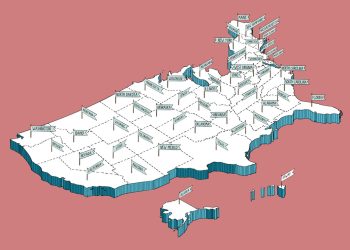Despite pressure from the Federal Reserve and a variety of market headwinds, the labor market has continued to defy expectations, posting another month of positive growth as the economy added 315,000 jobs in August, according to the latest data from the Bureau of Labor Statistics (BLS).
“The Fed had been hoping to see a slower pace of job growth after the very strong July jobs report, but the August data shows that the labor market continues to run very hot,” said Dr. Lisa Sturtevant, chief economist for Bright MLS, in a statement.
This month’s report was maybe the most closely watched in 2022, and was also a much smaller increase than July’s 526,000 new jobs. Policymakers have mostly agreed that the pace of growth in the labor market is unsustainable and needs to come down—hopefully without crashing.
Investors reacted positively to the report, with all three major indexes up around 1% in early trading Friday.
“While the labor market remains quite strong, with employment growth still above a sustainable pace…that pace is slowing,” said Mortgage Banker Association SVP and Chief Economist Mike Fratantoni in a statement. “Wage growth is still strong, with average hourly earnings up 5.2% compared to a year ago.”
Residential construction payrolls were up 10,900 from last month and 118,700 over the last year. Late last year, homebuilder advocates said that the industry needs to add 2.2 million new jobs in order to make up for retirements and meet demand.
Unemployment also ticked up, from 3.5% to 3.7%. Many economists have pointed to low unemployment as a sign that the economy isn’t in as much trouble as indicated by other data.
“The direction of the change is concerning, but the low overall level is still an indication of a robust economy,” said realtor.com® Senior Economic Research Analyst Joel Berner in a statement. “Low unemployment and the imbalance between job openings and job seekers led to pay increases.”
Wages continue to rise—still nowhere near the pace of inflation, but still up 5.2% from a year ago.
In the wake of three interest rate hikes by the Federal Reserve, observers expected the labor market to slow more quickly or more significantly as inflation has shown early signs of finally peaking. How this most recent report affects the central bank’s decision on raising rates again in September remains to be seen.
Sturtevant believes this report will be enough to push Fed chair Jerome Powell to enact another large increase to the benchmark rate.
“The Fed will have no choice but to raise rates again later this month, probably by another three-quarters of a percentage point,” she said. “This rate hike will impact the already sluggish housing market by pushing mortgage rates up further, with a growing likelihood that we will see average 30-year fixed-rate mortgage rates hit 6%.”
Before this jobs report, Fannie Mae had predicted that rates would average around 4.7% in Q1 2023. Rates have been volatile over the summer, with markets trying to price in the actions of a much more aggressive Fed.
Frantantoni agreed that the jobs report would almost certainly precipitate more rate hikes, taking a more optimistic view of how the housing market might react.
“We expect that the Federal Reserve will stay the course with further rate hikes at upcoming meetings,” he said. “The housing market is reeling from the hit to affordability from the spike in mortgage rates and much higher home prices. While these data don’t promise any near-term relief on rates, the strong job market will continue to support housing demand as household incomes continue to grow at a brisk pace.”
Berner saw the relatively positive job report as potentially masking much more serious issues for everyday consumers—as well as the economy as a whole, which is still facing a multitude of challenges.
“Rising prices, along with a relatively weak stock market, create a murky background for the good news about jobs and stoke fears about the possibility of a recession,” he said. “At an individual level, Americans are facing slow-growing wages, rising prices of consumer goods and rapidly increasing monthly costs for renting or buying places to live.”











